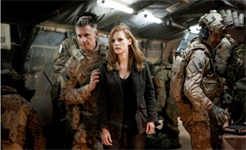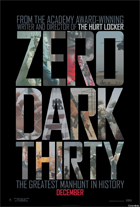Zero Dark Thirty
|  The fact that commentators, pundits, and politicians on both sides of the political spectrum are condemning Zero Dark Thirty, Kathryn Bigelow’s gripping hunt-for-Osama bin Laden procedural, is a sure sign that she and journalist-turned-screenwriter Mark Boal, reuniting after their Oscar-winning Iraq war drama The Hurt Locker (2008), have done something right. Bigelow and Boal don’t eschew politics—after all, how could they, given the charged subject matter?—but rather invest all of their film’s energy into the pressing details and bureaucratic nuances of what has become known as one of the greatest manhunts in modern history. The film is both a fiery American revenge tale, prefaced by a black screen filled with the terrified phone calls of 9/11 victims trapped in the burning towers, and a sharply etched depiction of military and intelligence professionals doing what they do—for better or for worse. Thus, how you respond to the film will rest largely on what politics you bring to the screen. The fact that commentators, pundits, and politicians on both sides of the political spectrum are condemning Zero Dark Thirty, Kathryn Bigelow’s gripping hunt-for-Osama bin Laden procedural, is a sure sign that she and journalist-turned-screenwriter Mark Boal, reuniting after their Oscar-winning Iraq war drama The Hurt Locker (2008), have done something right. Bigelow and Boal don’t eschew politics—after all, how could they, given the charged subject matter?—but rather invest all of their film’s energy into the pressing details and bureaucratic nuances of what has become known as one of the greatest manhunts in modern history. The film is both a fiery American revenge tale, prefaced by a black screen filled with the terrified phone calls of 9/11 victims trapped in the burning towers, and a sharply etched depiction of military and intelligence professionals doing what they do—for better or for worse. Thus, how you respond to the film will rest largely on what politics you bring to the screen.Bigelow and Boal challenge the audience from the outset, following the powerfully image-less 9/11 prologue with an immediate descent into the moral quagmire of torture—or enhanced interrogation, or whatever you want to call it. We are thrust into the grungy environs of a hidden CIA location in Afghanistan where a jihadist who helped fund the 9/11 attacks is strung up by his arms and being grilled under extreme duress by Dan (Jason Clarke), a burly, bearded CIA interrogator with a doctorate in psychology and an aptitude for switching between bad cop and good cop. We are also introduced to the film’s protagonist and chief point of audience identification: Maya (Jessica Chastain), a young CIA analyst recruited directly out of college in the wake of 9/11 to help determine the whereabouts of bin Laden. With her long red hair and porcelain skin, Maya looks immediately out of place in the shadows of a torture chamber, but as the film soon makes clear, looks can be deceiving. While she is clearly bothered by the intensity with which Dan is conducting his interrogation, which involves stripping the detainee naked for the sake of humiliation, denying him sleep, pummeling him with heavy metal music at deafening volumes, and, of course, waterboarding, she is a woman of steely resolve and intense determination—a “killer,” as another CIA agent puts it, although she never holds a gun. Rather, her weapons of choice are a fierce intelligence and an absolute refusal to quit; she’s a zealot with a mission, and her unwavering resilience unfolds over years of an achingly slow investigation filled with dead ends, bureaucratic roadblocks, and unexpected deaths. The opening torture sequence is crucial, as it establishes the stakes of the film’s narrative—How far are we willing to go to get the mastermind behind 9/11?—without necessarily celebrating or condemning the tactics used. The film makes clear that the interrogation techniques were effective insofar as they produced intelligence that eventually, although not directly, led to Osama bin Laden being located in a compound in Abbottabad, Pakistan. But, at the same time, Bigelow does not shy away from depicting the price of such dehumanization. The detainee (Reda Kateb) is not the kind of bile-spewing, anti-American animal that so many want to imagine most of the Muslim world to be, but rather a man with a gentle face, frail body, and pleading eyes who has already been beaten down to almost nothing; his suffering immediately humanizes him as a character ever as he is being systematically dehumanized by the interrogation process. Similarly, the effects of the torture register on Maya, who is distressed by what she is witnessing, but when given a chance to intervene, only encourages the detainee to talk lest he suffer more. Her moral compass is, like most of ours, forever caught in the crossfire between what we know is right and what we are willing to compromise if it might achieve our goals. Most of the film unfolds not in such dramatic locations, bur rather amid the mundane metal desks and file cabinets of various government offices where Maya works with other CIA agents, most notably Jessica (Jennifer Ehle), an al-Qaeda expert who starts as an antagonist (she and Maya have differing views on just about everything), but eventually becomes her friend and confidant, and Joseph Bradley (Kyle Chandler), the CIA station chief in Islamabad whose need to head off more terrorist attacks often conflicts with Maya’s single-minded goal of finding bin Laden. Maya is the prototypical Hollywood rebel-hero, operating as a kind of lone wolf due to her theory that bin Laden is not holed up in a cave in the mountains between Pakistan and Afghanistan, but is rather hiding in plain sight in an urban area. Because we know she was right, it is almost too easy to identify with her struggle to get others to buy into her premise. Her struggle is both theoretical and practical, made all the more grueling with each passing year, although she remains to some extent frustratingly distant, a figure who fascinates, but about whom we learn virtually nothing, which may very well be the point. Missions like finding bin Laden—the proverbial needle in the haystack—requires people who are willing to sacrifice everything and be nothing outside of the mission (Ben Affleck dealt with this same issue in Argo, but with a decidedly sentimental bent). Like any great procedural, much of Zero Dark Thirty’s tension resides in the details, and even though we know how it will all turn out (the title of the film is military speak for 12:30, the time bin Laden was killed), Bigelow keeps the film taut and on edge, as if she might at the end rewrite history and let bin Laden get away. Alas, it’s no spoiler to say that she doesn’t, and the film’s climactic depiction of the now infamous raid by Navy SEAL Team Six on bin Laden’s compound is a work of brilliance, fusing our fevered imagining of what went down that night with a mastery of cinematic technique. Like The Hurt Locker, Bigelow and cinematographer Greig Fraser (Let Me In) are working in a faux-documentary style of striking immediacy. Throughout the raid we are limited largely to the vantage point of the various SEAL members (much of what we see is rendered through the hazy green of their night-vision goggles), which makes every doorway and corner a site of potential danger, and the entire sequence literally crackles with tension. However, what is most striking about the whole sequence is how the cathartic rush of bin Laden’s death is quickly subsumed by the realities of the larger world. He is, after all, only one man, and while his killing was a great symbolic victory, the world remains a frighteningly dangerous place, a sentiment that seems etched on Maya’s exhausted countenance in the film’s final moments. The battle may be won, but the war rages on. Copyright ©2013 James Kendrick Thoughts? E-mail James Kendrick All images copyright © Columbia Pictures |
Overall Rating: 


 (3.5)
(3.5)


